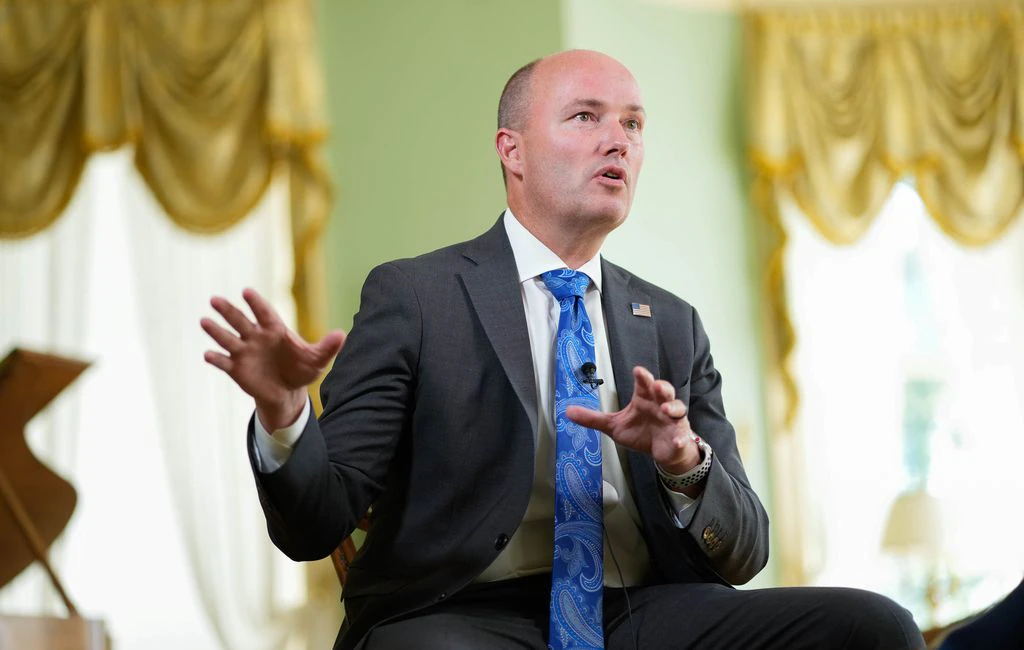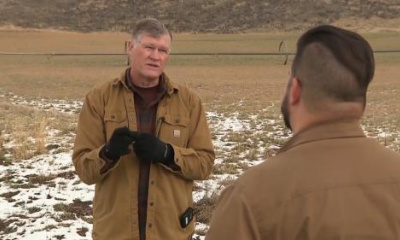From landmark reforms to state water laws to big investments in infrastructure, he believes it’s not too late for the Great Salt Lake.
Utahns’ water consumption habits have drawn national scrutiny in recent weeks, sometimes to an embarrassing degree.
The Great Salt Lake sank to a record low for the second time in less than a year, with its plight grabbing the attention of The New York Times and CBS. HBO’s John Oliver famously took Utah to task this summer for its dwindling water resources and a video of Gov. Spencer Cox calling on people to “pray for rain.”
Cox has been quick to defend his home state amid all the negative press, pointing out in a Twitter thread earlier this month the major steps taken to save the Great Salt Lake from further decline.
Still, he acknowledged in an interview this week with the Great Salt Lake Collaborative that the Utahns haven’t historically always been the best stewards of their water resources. Read the full interview transcript here.
“It is a fair criticism that we haven’t been as effective as we should have been in the past when it comes to conserving water,” Cox said, “and specifically the Great Salt Lake.”
When Mormon pioneers settled the Salt Lake Valley, they quickly went to work building canals and irrigation systems to ensure their arid region had more than enough water to get by, the governor noted. Those supplies later were bolstered by multimillion-dollar federal projects that built the state’s many large reservoirs.
“That’s led us to this point where I think we got a little lackadaisical,” Cox said. “Why conserve when you don’t have to?”
But with the state’s rapidly growing population, the current “megadrought” gripping the West, and the Great Salt Lake on the verge of turning into a toxic dust bowl, the governor said it’s time for a “paradigm shift” in mindset for both residents and lawmakers.
“Getting 3 million people to change that paradigm is tough,” Cox said, “but we’re getting there. And so I’m optimistic about where we’re headed.”
$500 million in water-saving measures
Fueling the governor’s optimism is the slew of water conservation bills state legislators passed this year.
“They hold the purse strings,” Cox said, “and so much of this is about money.”
Cox lauded nearly $500 million invested in water-saving measures this year. But the governor conceded that much of that spending would not have been possible without federal pandemic aid. HB242, for example, is a sweeping bill that will require meters on nearly every secondary water connection across the state. Its $250 million price tag was funded by the American Rescue Plan Act.
“It would not have been possible to get that high of a number without the pandemic aid,” Cox said. “There’s no question.”
While secondary meters will give Utahns a better understanding of how much water they are using outdoors — and provide water districts a mechanism to charge for that use — the governor acknowledged agriculture still gulps the lion’s share of the state’s water.
“There is a balance, and there’s no question that agriculture has to play a huge role in this,” Cox said. But, as a farmer himself, he defended the state’s agricultural industry.
“When we’re in a drought situation, nobody — nobody — loses more water than agriculture,” Cox said. “We had a 75% reduction last year. I don’t know anybody that took a 75% reduction on their lawns or a 75% reduction in their drinking water.”
He also brushed off the notion that the bulk of the state’s farmland is used to grow hay that is shipped out of state.
“There’s this idea that we grow alfalfa here, and we sell it to China,” Cox said. “That’s a very, very small percentage of the agriculture production here in this state.”
In a follow-up interview, Utah State University assistant professor Matt Yost said it is difficult to nail down an exact figure on how much alfalfa the state exports.
“Based on the best estimates I’ve seen from economists and agronomists in the West, Utah’s exports are likely between 7% and 17%,” Yost said, although he noted a recent University of Utah analysis found exports could be as high as 30%.
Said Yost: “It’s certainly not the majority.”
Water leases in the works
On making a difference using agriculture, Cox noted that one of the most significant pieces of legislation he signed last session was HB33. That bill allows water rights holders to temporarily lease their water to the state to benefit the environment, including the Great Salt Lake.
“We changed the law,” he said, “for the first time in our state’s history —175 years since those first pioneers came here — this use-it-or-lose-it mechanism.”
The state is negotiating with several partners to secure donated or leased water to boost stream flows and ensure that water tickles all the way to Utah’s iconic but beleaguered terminal lake.
In a follow-up request sent to the Utah Department of Natural Resources, a spokesperson confirmed the state is not currently leasing water to benefit the Great Salt Lake because the details of those agreements are still getting ironed out.
The governor confirmed that Utah’s predominant faith, The Church of Jesus Christ of Latter-day Saints, is among the interested parties.
“That’s one of the organizations we’re having conversations with,” Cox said.
The Salt Lake City-based church has a vast array of landholdings in Utah and across the United States, according to an admittedly incomplete database created by the Truth & Transparency Foundation and reported in The Salt Lake Tribune, making it one of the nation’s top private property owners. A query of that database revealed more than 400 parcels categorized as “agricultural assets” or other farmlands owned by the church’s many real estate arms within the Great Salt Lake’s watershed.
(A church spokesperson did not respond to a request for comment Wednesday.)
It’s not just agricultural irrigators who are interested in negotiating water sharing with the state.
“We’re actively — anybody that is on that river system, we’re having conversations with them,” Cox said. “... So far it’s going very, very well. We’re hoping to have some announcements over the next couple of months.”
More legislation benefiting the Great Salt Lake is in the works as well, Cox said, adding that a helicopter tour of the lake’s massive dry lakebed had a profound effect on lawmakers last session.
“That single thing,” Cox said, “did more than every press conference, every newspaper article, every letter I sent to them.”
Asked why it took the Great Salt Lake reaching a record low for state leaders to take meaningful action on water conservation, the governor emphasized his focus on the present, not the past.
“Should we have started earlier? Probably,” Cox said. “But we are where we are now. And we’ve got the momentum moving forward to make a big difference.”
Other interview highlights:
Bear River development • Utah has plans to dam the Bear River — the Great Salt Lake’s largest tributary. That project has been pushed off until 2050 due to water conservation efforts. Given the state of the lake, the governor confirmed he has no intention to push Bear River development, at least in the near term.
“There’s not enough water for that to happen right now,” Cox said. “But that could change in five years, in 10 years. And so we’re dealing with the problems that we have now.”
Pipeline to the Pacific • Lawmakers are exploring a pipeline to the Pacific Ocean to help refill the Great Salt Lake. Given the immense cost and interstate negotiations the project would require, Cox called it a “long shot” solution.
“I will admit at the top I’m very dubious,” he said. “However, I think we owe it to everyone to look at every possibility out there.”
Importance of agriculture • As Utahns call into question agriculture’s role in recent water shortages, Cox stressed the importance of a local food supply.
“One of the things we learned during this pandemic is that we need to be able to grow some of our own food here in this state,” Cox said. “It’s really important, as supply chains broke down, to make sure that we’re doing that.”
Climate change • Most climate models indicate a future in which Utah becomes hotter and drier, prone to more natural disasters. Its snowpack and water supply will become less reliable. But the governor implied the Great Salt Lake isn’t necessarily doomed.
“Most people have no idea,” he said, “that in 1963, it was almost as low as it is right now.”
(In October 1963, the Great Salt Lake hit a low elevation of 4,191.35 feet above sea level. As of Wednesday, it sat at 4,189.9 feet. It is expected to keep receding until cooler weather comes in the fall.)
“Climate patterns change,” Cox continued. “And right now, we’re in a dry climate pattern that could shift over time. We don’t know. We’re hopeful, but we have to do everything possible to save that lake right now.”
Water woes in the Colorado Basin • The Great Salt Lake isn’t the only major body of water imperiled by consumption, drought and climate change. Lake Powell has shriveled to its lowest point since it began filling, putting water supplies and power generation for multiple states at risk.
The Bureau of Reclamation recently called for up to 4 million acre-feet in water use cuts by the seven states in the Colorado River Basin by the end of next year. This could pit upper basin states, including Utah, against lower basin states like California that have historically consumed more water.
“We have always said that whiskey’s for drinking and water’s for fighting. That’s kind of the model in the West,” Cox said. “But I will tell you that the Colorado River Basin is the one drainage where we’ve never had a lawsuit. It’s the one drainage where we’ve always figured out how to divide it up responsibly and work together.”
Even so, Cox and Utah lawmakers are working with other upper basin governors to assemble “the best legal minds” as they prepare for negotiations.
“There’s going to be some posturing, and we’re going to be part of that,” Cox said. “... There’s not as much water as we thought there was. At the same time, the lower basin states have overused their portion of the water and have for a long time.”









